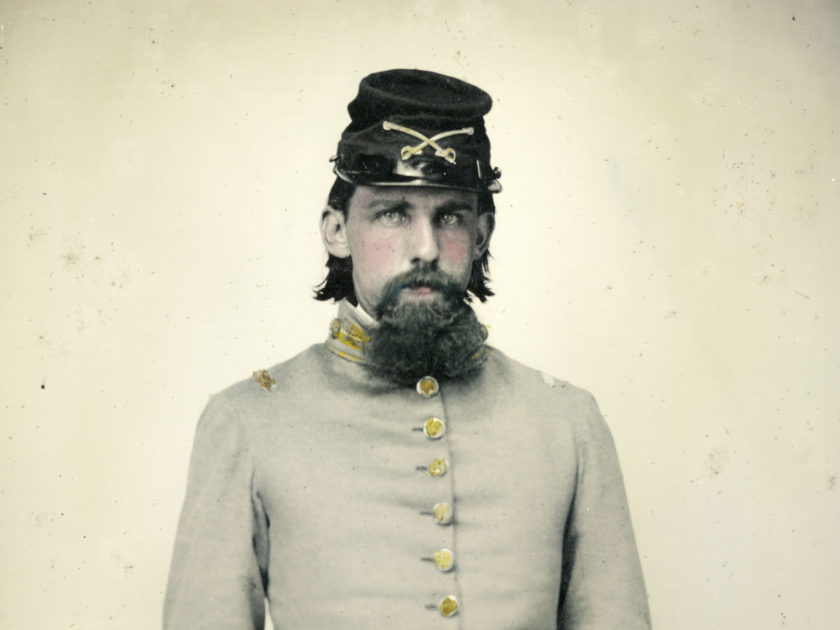By Ron Field
The militia and volunteers of the Palmetto State were the first troops to see service in defense of the short-lived Republic of South Carolina in 1861, and some of the last to defend the Confederate States of America in 1865. During that time, 12,922 South Carolinians soldiers died—almost a quarter of its male white population of fighting age.
Most of these men were photographed before they saw action. Some never fired a shot in anger, but became casualties from diseases in camp. Others sacrificed their lives on the battlefield or died of their wounds. Many had their image “struck” by some of the best photographic artists in the South, including George S. Cook and Charles J. Quinby of Charleston and Charles R. Rees of Richmond, Va. The pride and stoicism evoked by these portraits stand as a monument to Southern sacrifice.
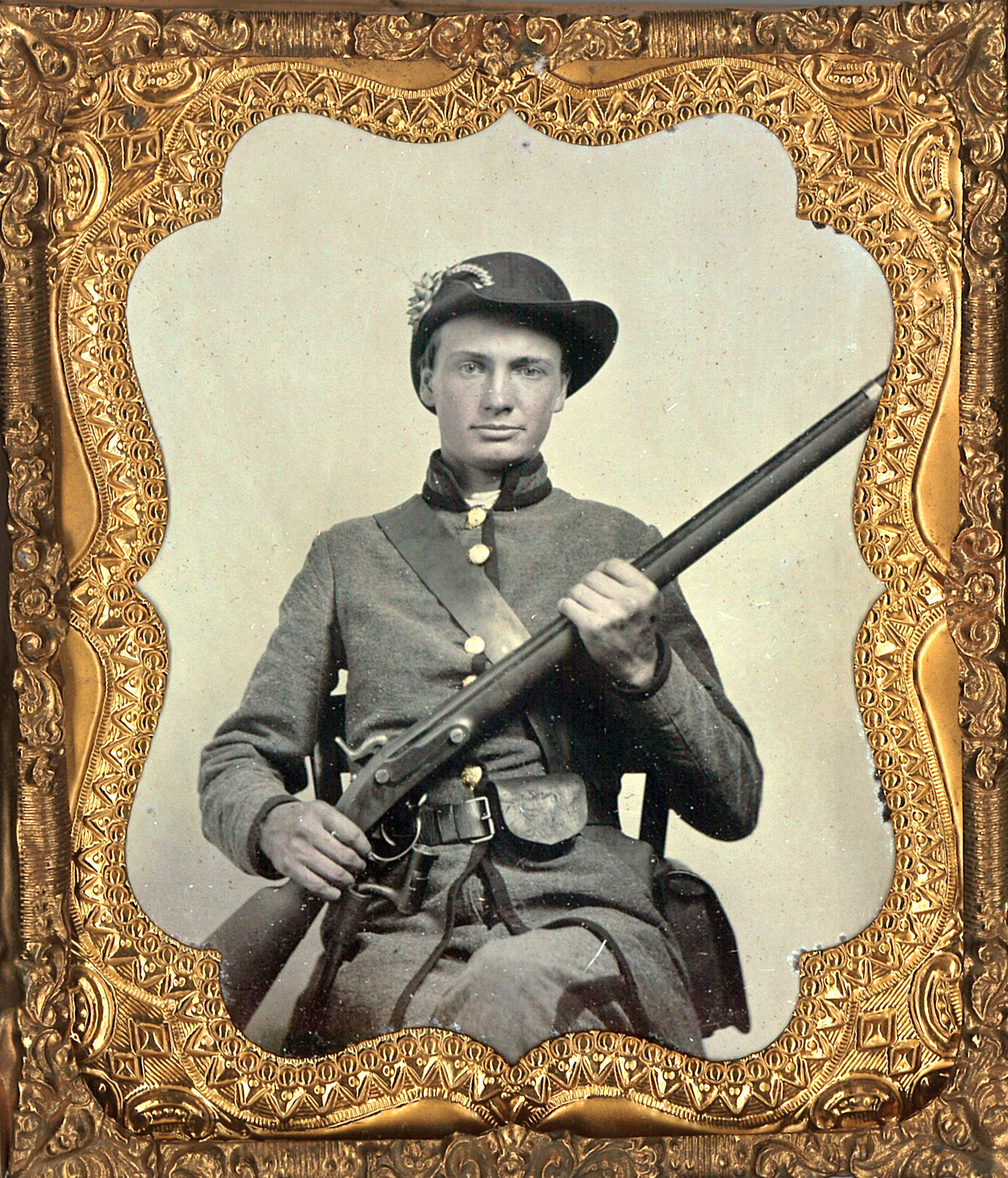
Secession Cockade
The palmetto fronds that adorn the secession cockade attached to the hat of this Confederate soldier identify him as a South Carolinian. Two details suggest he served in the 1st South Carololina Rifles, also known as Orr’s Rifles for its original commander, Col. James L. Orr: the trim on his frock coat and the Model 1822 conversion musket issued to the regiment. His cartridge box and sling, narrow waist belt, with roller buckle and cap pouch with shield-shaped flap, were likely standard issue.

Swapped with an Artilleryman
As a result of an 1861 act of the Provisional Confederate Congress, cavalrymen were required to provide their own mounts. For one trooper, the act cost him his place in the ranks. Pvt. William Stone enlisted in the Wassamassaw Cavalry at Mount Pleasant, S.C., in May 1862, which became Company D of the 2nd South Carolina Cavalry. Later that year he lost his horse for reasons unknown and was absent without leave for a month while he searched for a replacement. This practice thinned the ranks of the Confederate cavalry throughout the war.
Stone eventually acquired a new mount, but by March 1864, he found himself horseless again, without explanation. Unable to find a replacement, Stone was ordered to swap places with an artilleryman that had a horse. Stone served in the Mathews Artillery unit until the surrender at Appomattox Court House.
Stone posed for this photograph in the Richmond gallery of Charles R. Rees after he and his fellow cavalrymen arrived in Virginia.
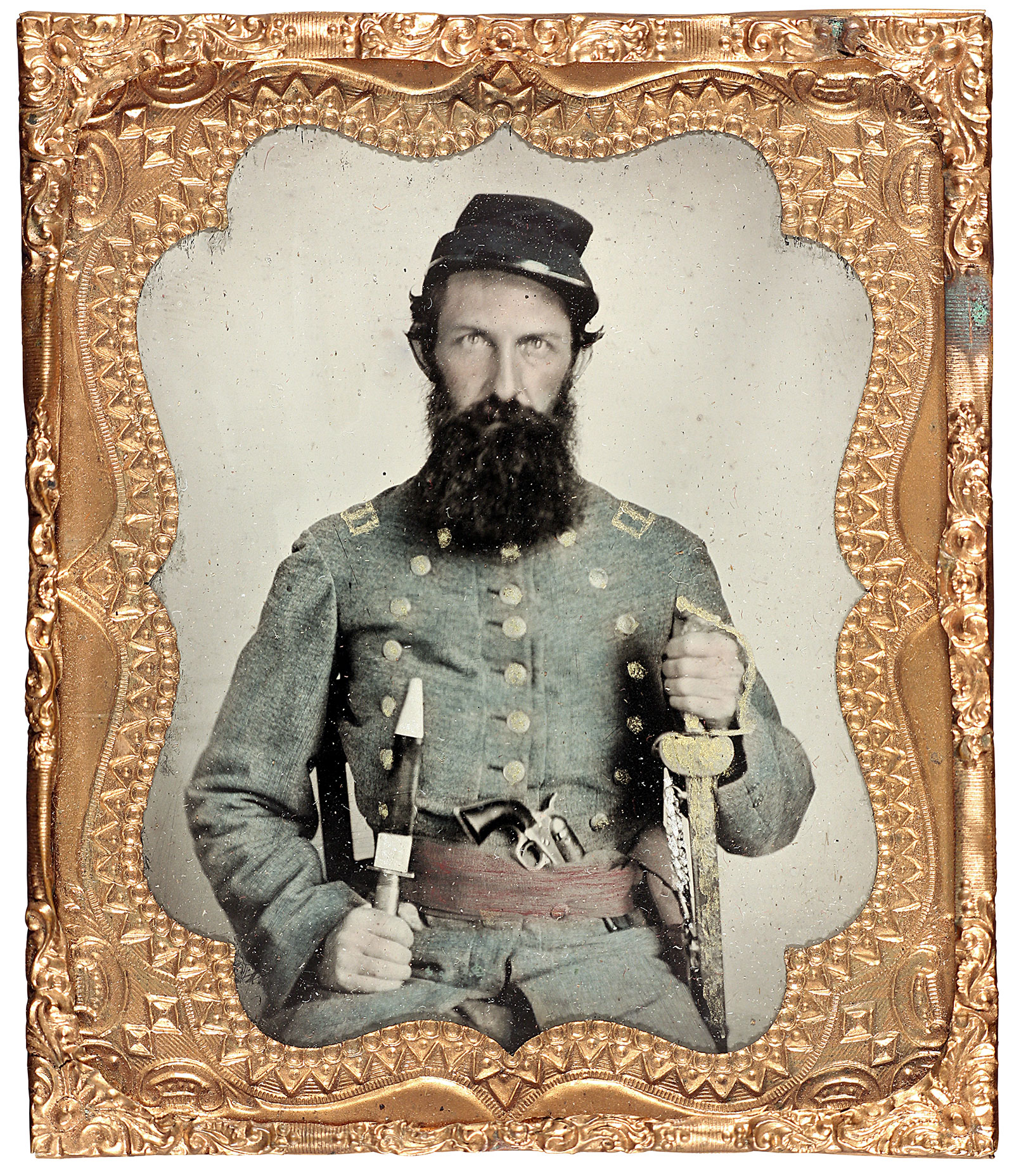
Sixth-plate tintype by an anonymous photographer. David W. Vaughan collection.
Late for Manassas, Early for Death
On June 29, 1861, Darius Fred Gandy was elected first lieutenant of the Hartsville Light Infantry at Darlington Court House, S.C. He and his fellow militiamen became Company G of the 9th South Carolina Volunteers—one of two companies in the regiment armed with Mississippi rifles. The. The 9th arrived too late to participate in the Battle of First Manassas on July 21, 1861. Later in camp at nearby McLean’s Ford, Va., disease spread rapidly through its ranks. Gandy was among those who fell ill. He resigned his commission on Nov. 18, 1861, and died of typhoid pneumonia 11 days later at the South Carolina Hospital at Warren Springs, Va.
Gandy’s coarsely woven frock coat with three rows of buttons and federal style shoulder straps were probably part of the uniform worn by the Hartsville Light Infantry. He grasps a sheathed knife and eagle head infantry officer’s sword with counterguard and pearl grip, and carries a Model 1849 Pocket Colt revolver tucked in his waist sash.

Son of South Carolina
This infantry private is without question a son of South Carolina, as evidenced by the palmetto device on his cap and uniform buttons embossed with the state coat of arms. Identified as Joseph Wilcott McPherson in William A. Albaugh’s volume Confederate Faces (1970), no records for a soldier with this name have been found.

Sixth-plate ambrotype by an anonymous photographer. Richard Ferry collection.
A Trooper’s Distinctive Coat and Cap
This cavalryman sports the “Beauregard Cap” complete with a palmetto insignia attached to the front. The hat may be named for Gen. Pierre G.T. Beauregard, though there is no evidence that he ever wore such headgear. Two clues suggest that this trooper may have been connected to Charleston: The cap design is similar to a pattern made by hatters in the city, and the braid on his coat resembles that worn by the South Carolina Rangers.
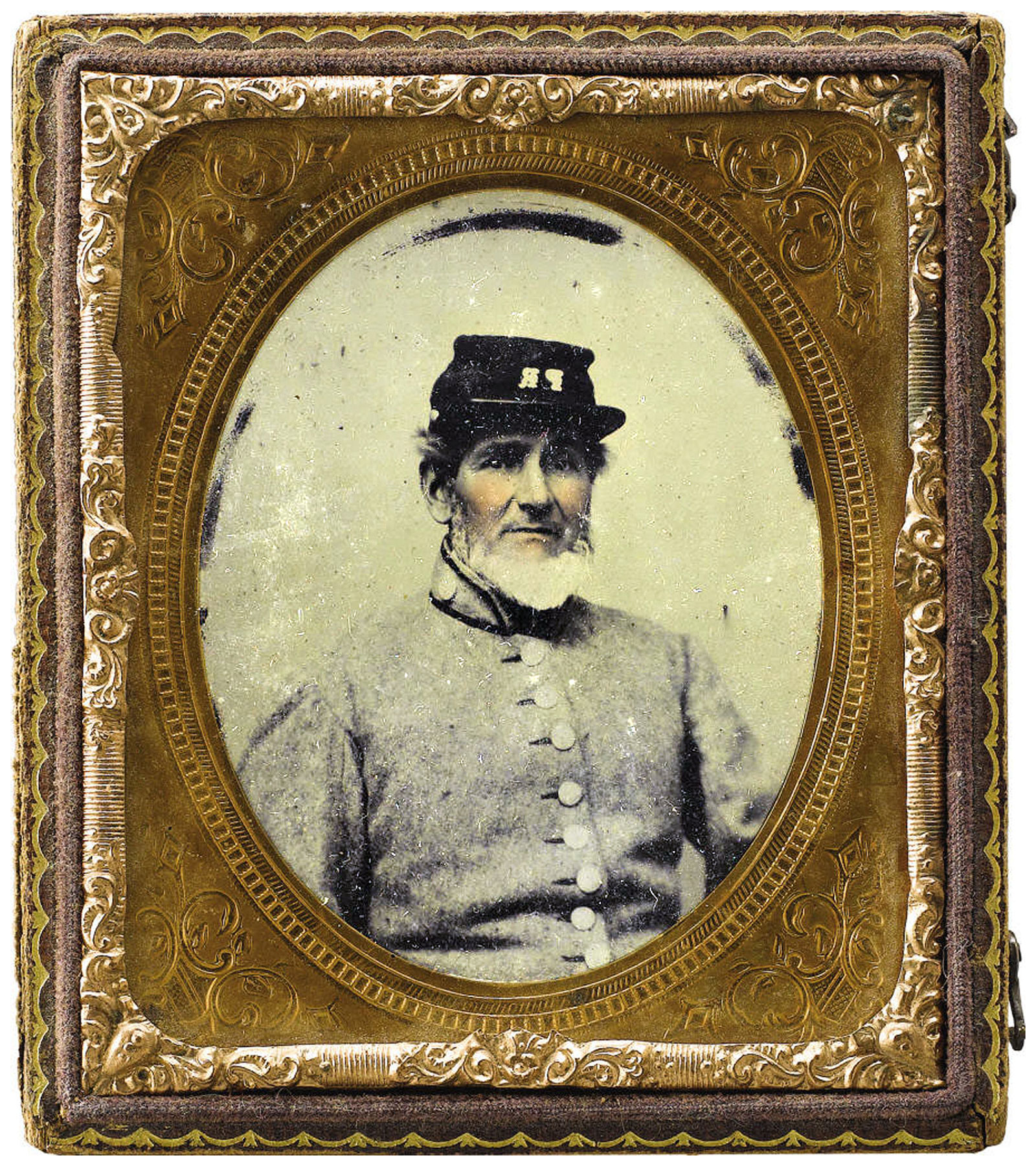
Phoenix Rifleman
The letters “PR” on the cap indicates the wearer as a member of the Phoenix Rifles. The militia group was organized by Charleston’s Phoenix Fire Company on Dec. 5, 1860, about two weeks before delegates at a secession convention in Columbia voted unanimously to secede from the Union.
The uniform worn by this elderly militiaman dates to January 1861.

Captured near Drewry’s Bluff, Died at Elmira
Philip Evan Thomas enlisted as a private in the St. James Mounted Riflemen at Santee, S.C., in March 1862. He and his company spent the first two years of their enlistment in coastal South Carolina. By March 1864, the Riflemen, now Company E of the 5th South Carolina Cavalry, were ordered to Virginia with the rest of its regiment. Actively engaged in fighting during The Wilderness, Cold Harbor and south of the James River, Thomas was captured near Drewry’s Bluff on May 16, 1864. His odyssey as a prisoner of war took him from Fortress Monroe to Point Lookout, Md., and finally to the prison camp at Elmira, N.Y., where he died of typhoid fever on Oct. 1, 1864.

Boy Militia Soldier Turned Citadel Cadet
In 1861, Moses Sanders Haynesworth, 16, posed for this photograph, attired in the enlisted men’s uniform of the Darlington Guards. He and his fellow militiamen became Company B of the 1st South Carolina Volunteers, also known as Gregg’s Regiment for its commander, Col. Maxcy Gregg, for six months in 1861.
After their stint expired, most of Haynesworth’s comrades reenlisted in Company A of the 8th South Carolina Volunteers, also known as Cash’s Regiment for Col. Ellerbe B.C. Cash. The under-aged Haynesworth remained behind in Charleston and was admitted to the Citadel. He went on to serve in the Charleston defenses during the summer of 1863 as a private in Company A of the Battalion of State Cadets.
Haynesworth survived the war and lived until 1928.

Sixth-plate ambrotype by an anonymous photographer. Paul Reeder collection.
Casualty at Second Manassas
Thomas G. Sheppard, an 18-year-old clerk in Charleston, enlisted as a private in the Carolina Light Infantry Volunteers in the summer of 1861. He and his comrades mustered into Confederate service as Company L of the 1st South Carolina Volunteers (Gregg’s). Sheppard went on to Virginia and survived disease-ridden encampments and fighting through the engagements of the Seven Days,’ only to be mortally wounded at the Battle of Second Manassas on Aug. 29, 1862. He lingered for 19 days before he succumbed to his wounds at a hospital in Warrenton, Va. He was unmarried.
Sheppard likely posed for this portrait shortly after enlistment. The Model 1842 musket he holds was standard issue and his waist belt plate was intentionally worn upside down to compensate for the reversed effect of the ambrotype process.
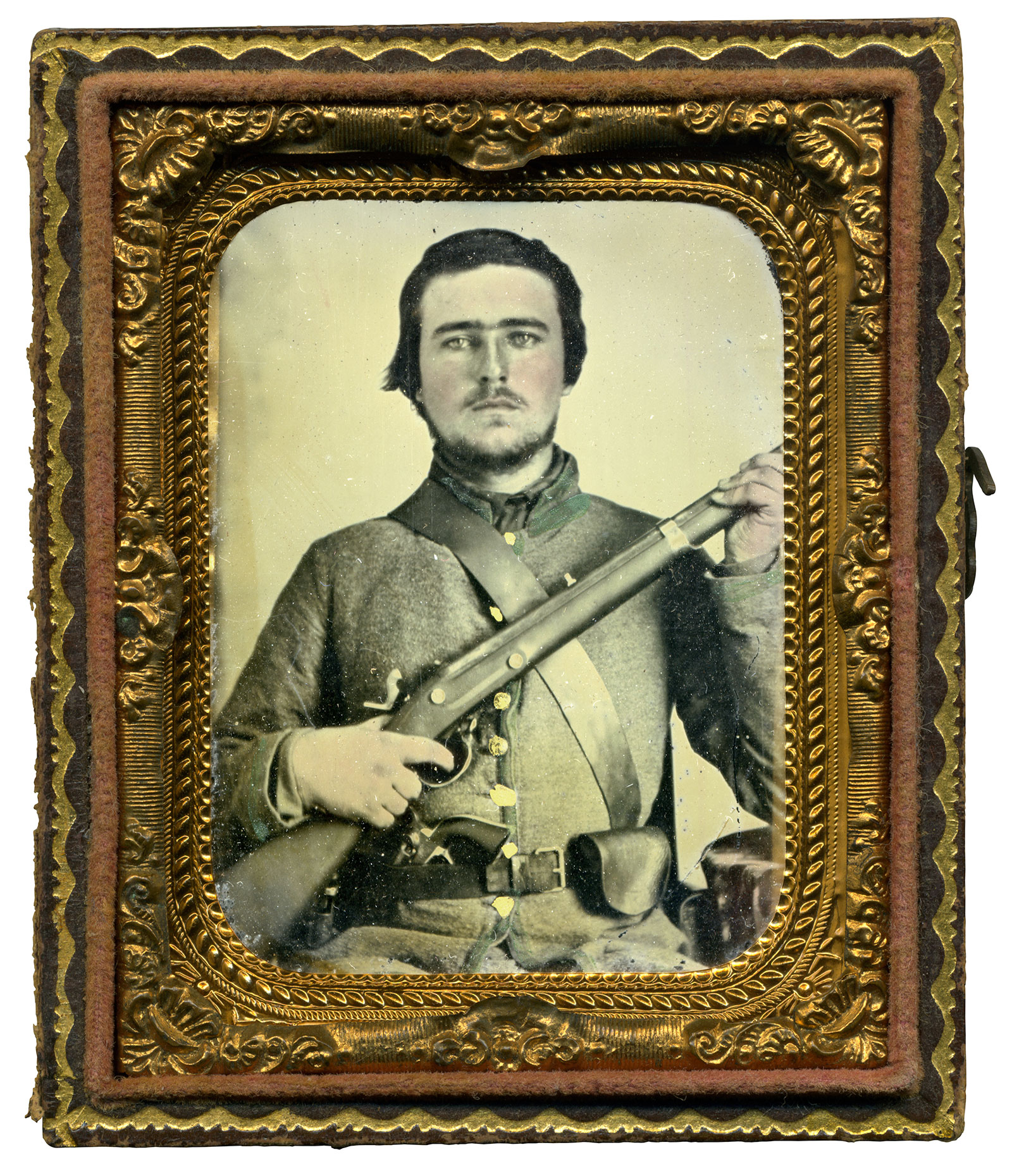
Copy of a ninth-plate ambrotype by an anonymous photographer. Courtesy of Matthew Fleming.
One of Orr’s Rifleman
The soldier in this image is tentatively identified as William H. Austin, a private in Company G of the 1st South Carolina Rifles (Orr’s Rifles). Several details suggest that the sitter may indeed be him. The rifled smoothbore musket in his hands was probably the weapon issued to him. At least seven companies of the regiment received Model 1822 muskets converted to percussion and rifled. The green trim on his uniform is correct for a regiment of rifles.
Another detail points to this photograph being taken before October 1861. The rank and file of the 1st received a uniform of heavy brown jeans material about that time, in preparation for the winter months. His uniform is of a lighter weight material. The Model 1849 Pocket Colt revolver tucked in his belt was probably a photographer’s prop.
The 1st mustered into Confederate service on July 20, 1861. The regiment moved into Virginia in April 1862 with more than 1,000 men, and went on to participate in most of the hottest battles with Gen. Lee’s army, including Antietam, Gettysburg, The Wilderness and Spotsylvania. The remnants of the regiment, 9 officers and 148 men, were surrendered at Appomattox Court House on April 9, 1865.
Austin was discharged at Camp Perrin, Va., in June 1862, by reason of “ordinary disability,” or unfitness for duty.
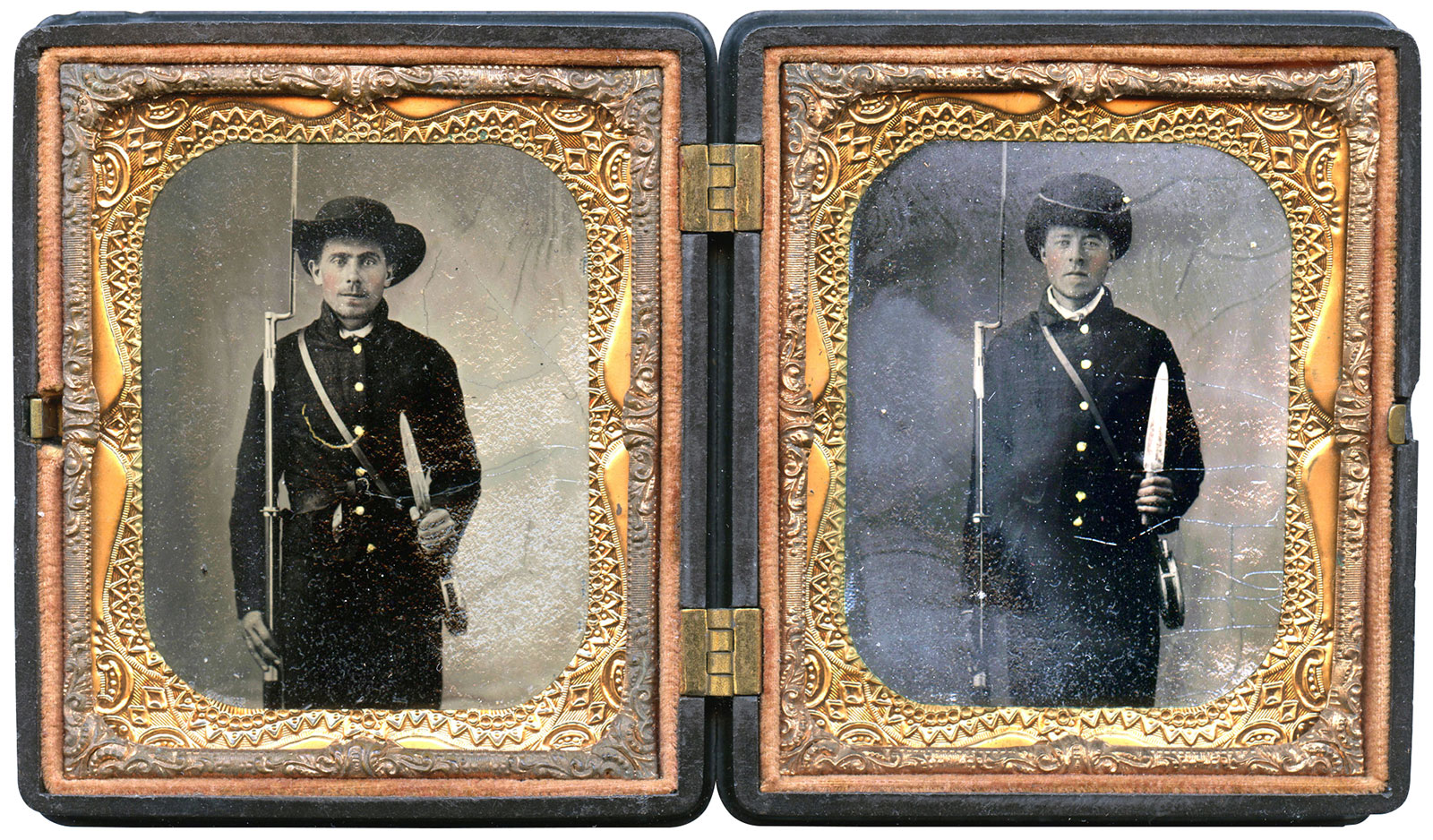
Sixth-plate melainotypes by an anonymous photographer. Courtesy of Sean Seifer.
“Order—ARMS”
Discovered in Greenville, S.C., these early war portraits of two volunteers may show brothers. Each poses with the same combination of musket, spear-pointed knife, and tin drum canteen—possibly photographer’s props. Following Hardee’s Rifle and Light Infantry Tactics manual, the soldiers hold their musket at “Order—ARMS.” Both wear six-button jackets of coarsely woven cloth with matching pants. The man at left has a militia-style waist belt with two roller buckles to which is attached his bayonet scabbard. The man at right appears to have the brim of his hat looped up on both sides and attached to the crown by small buttons. Companies recruited in Greenville District in 1861 included the Tyger Volunteers and Saluda Volunteers. They became Companies F and G of the 4th South Carolina Volunteers.

Portrait by a Photographer of Post-Destruction Columbia
Affixed to the mat of this image of an unidentified Confederate second lieutenant is a label crediting photographer Richard Wearn. Born in the Isle of Wight, Wearn immigrated to South Carolina in 1850. Nine years later he opened his “Premium Photograph and Ambrotype Gallery” in Columbia. By 1860, Wearn had established a partnership with portrait painter and colorist William Preston Hix. The pair worked together for the next 15 years, with the exception of a few years during the war, when Hix was absent, possibly serving in the Confederate army. The partnership dissolved in 1874 after Wearn committed suicide. Wearn is perhaps best known for a series of 19 cartes de visite of downtown Columbia after its destruction by Maj. Gen. William T. Sherman’s army in February 1865.
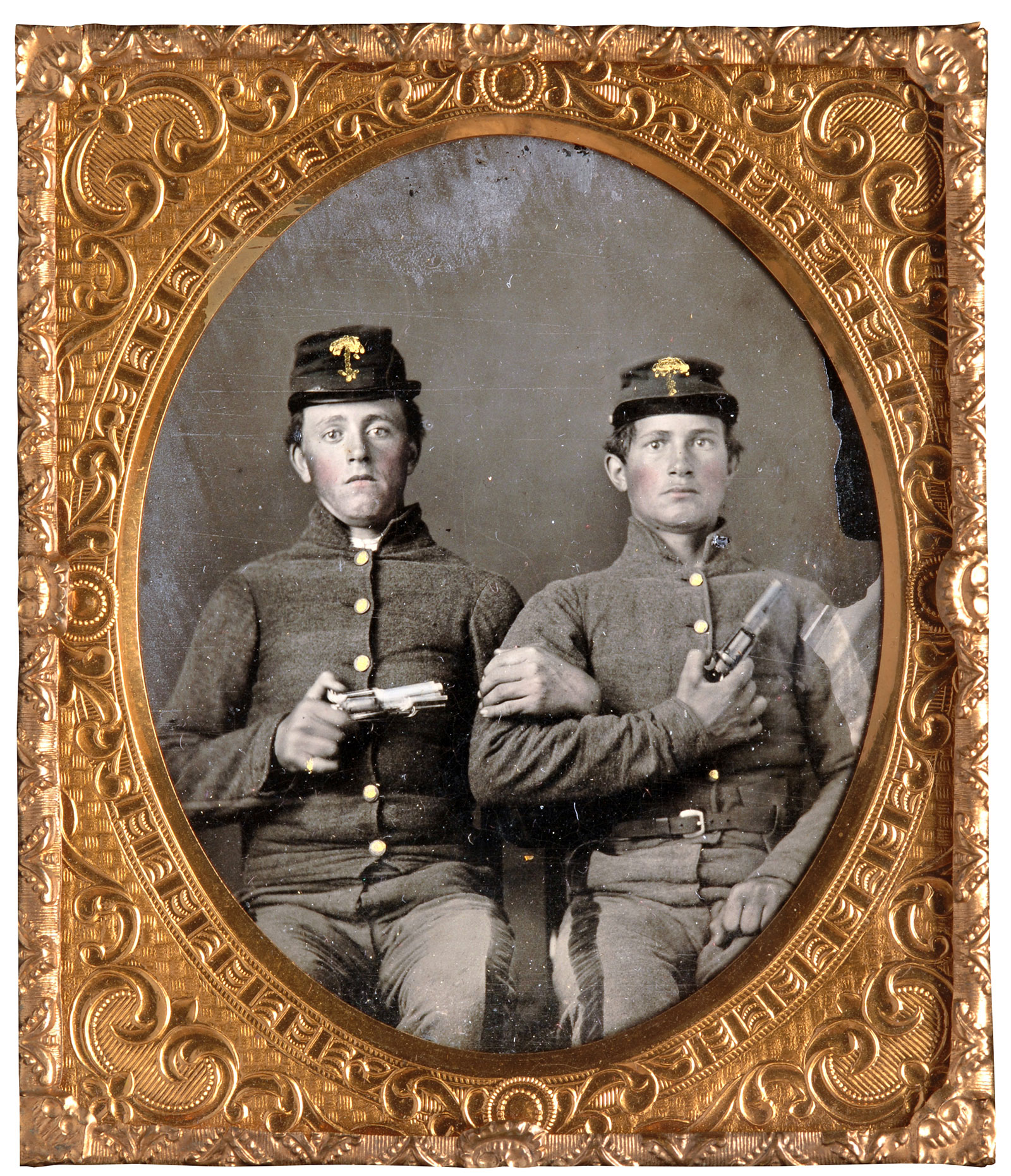
Sixth-plate ambrotype by an anonymous photographer. David W. Vaughan collection.
The Ferguson Boys Go to War
Identified only by the surname Ferguson, these two privates were probably John W. Ferguson, 19, and Henry J. Ferguson, 17, of Cross Anchor, a community south of Spartanburg, S.C. On April 14, 1861, the boys enlisted in the Cross Anchor Volunteers. The matching uniforms and headgear suggest that this image was taken shortly after their enrollment. They both proudly pose holding Model 1849 Pocket Colt revolvers.
The Cross Anchor Volunteers mustered for Confederate service as Company F of the 3rd South Carolina Infantry. The Ferguson boys did not remain with the company for long. James transferred to Company D. Henry was declared underage and discharged in February 1862.

Cavaliers of South Carolina
The ranks of the Beaufort District Troop, a cavalry company raised southwest of Charleston, S.C., included the Boynton brothers of Walterboro, who enlisted as privates in June 1861. Stephen D. Boynton, 23, and 19-year-old Moses M. Boynton provided their own horses and much of their equipment following Confederate protocol. The brothers, members of the cavalry arm of Hampton’s Legion, conducted scouts, raids and reconnaissance expeditions along the banks of the Potomac and Occoquan rivers in Virginia in late 1861.
In May 1862, during the withdrawal from Yorktown during the Peninsula Campaign, a portion of the Hampton Legion cavalry encountered their Union counterparts. Eighty of the Legion’s troopers, including the Boyntons, made “a brilliant dash” against a much larger force of the 6th U.S. Cavalry. In a short, bloody skirmish, they took 14 federals prisoner and killed 20. Stephen Boynton and another South Carolinian died in action. Gen. Wade Hampton issued a General Order of congratulations for his “cavaliers of South Carolina.”
Moses went on to serve in Company A of the 3rd South Carolina Cavalry. He last appeared on a military record with a rank of second lieutenant in October 1864.
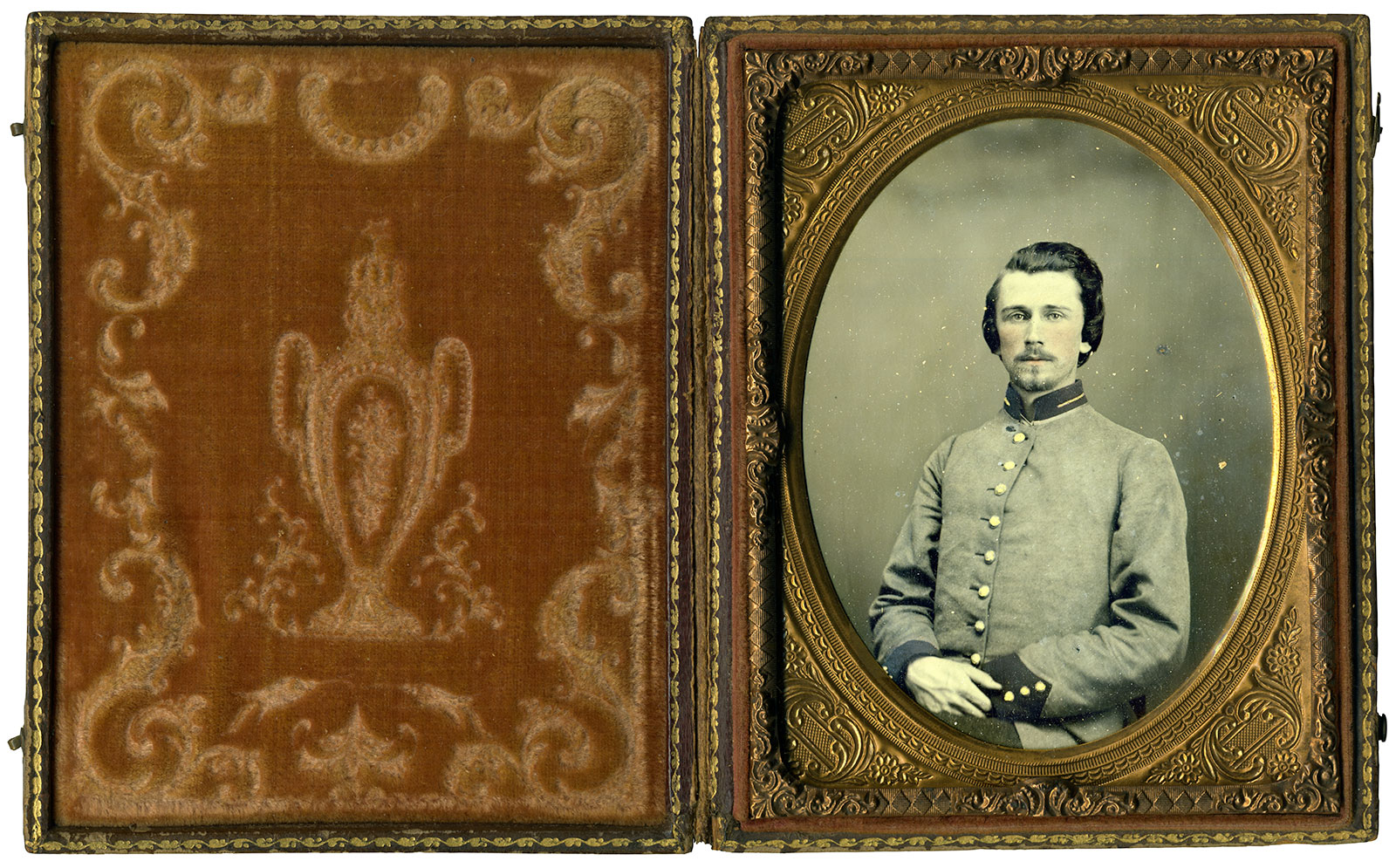
Quarter-plate ruby ambrotype by an anonymous photographer. The Liljenquist Family Collection, Library of Congress.
Wounded in the Defense of Fort Wagner
The nighttime assault against Fort Wagner by the 54th Massachusetts Infantry and other Union forces on July 18, 1863, cost the federals 1,500 men. The Confederate defenders suffered about 200 casualties, including Capt. Warren Adams. He was wounded in the back and head as he commanded Wagner’s guns.
An 1859 Citadel graduate, Adams was the son of James Hopkins Adams, a former governor of the Palmetto State and a signer of the ordinance of secession. Young Adams began his service as a first lieutenant in the 1st Infantry regiment of the short-lived Army of South Carolina. Prior to the bombardment of Fort Sumter, he was appointed an aide de camp to army commander Brig. Gen. R.G.M. Dunovant. On the night of April 11, 1861, with hostilities imminent, he was assigned to carry orders between Fort Moultrie and Mortar Battery No. 2.
Following the capture of Sumter, Adams and the 1st served mainly as artillery in the defenses of Charleston. In May 1863, the regiment was converted into the 3rd South Carolina Artillery and Adams received a promotion to captain of Company H.
Adams had advanced to major by the time Charleston was evacuated in February 1865. The regiment was later converted back to infantry. He was promoted to lieutenant colonel and participated in the North Carolina Campaign. Adams suffered his second wound of the war, in the left chest, near Bentonville, N.C., in late March 1865. The injury however, was not life threatening, and he returned to duty on April 1. He surrendered with Gen. Joseph E. Johnston’s army, and was paroled at Greensboro on April 26, 1865.
Adams is shown here dressed in a frock coat with a single row of nine buttons rather than the official two rows of seven. This suggests he sat for this portrait prior to the June 1861 standardization of Confederate uniform regulations.
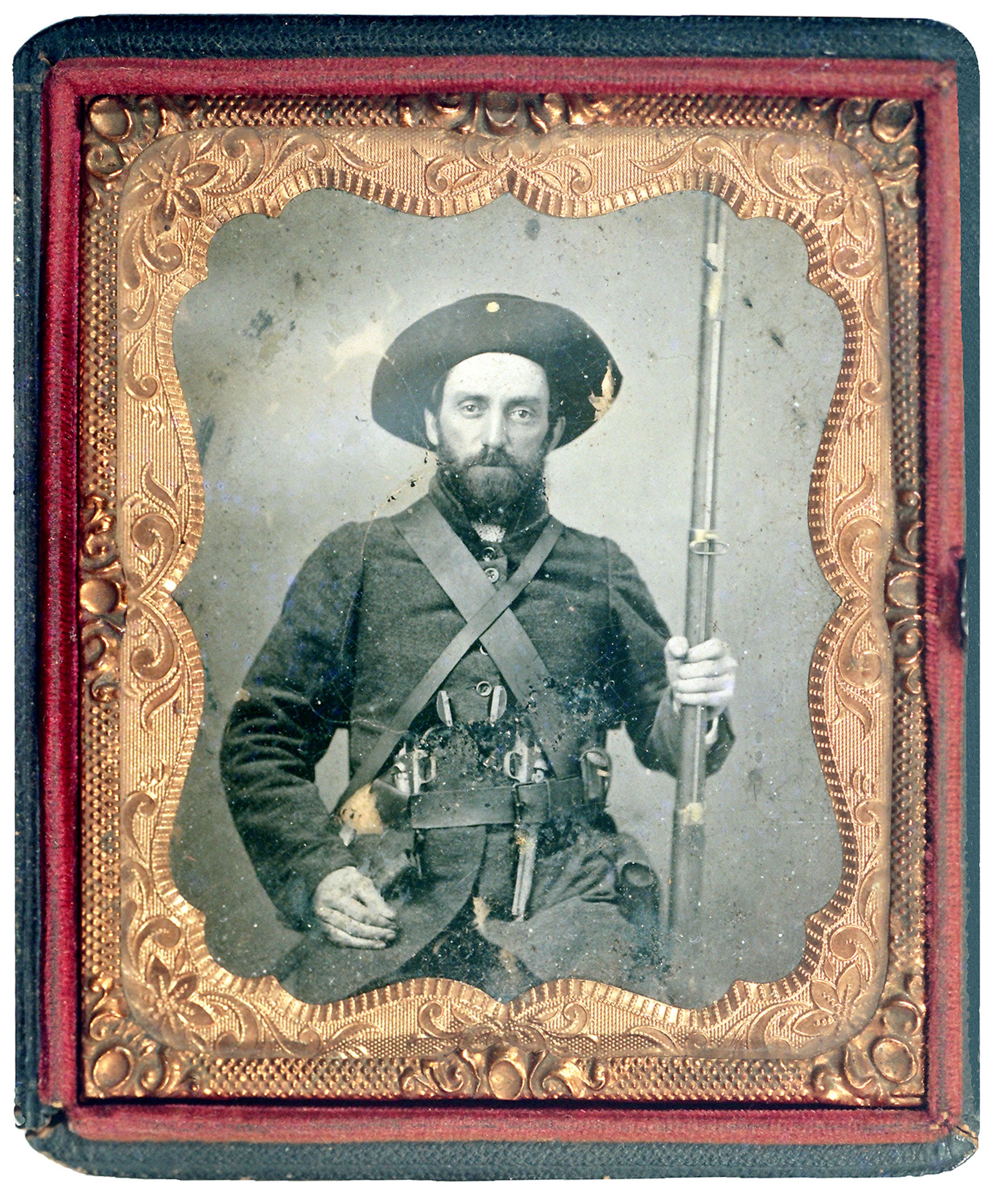
Captured in Virginia
On March 30, 1863, near Catlett’s Station, Va., troopers from the 8th Illinois Cavalry captured Pvt. John Stanyarne Shoolbred. A member of Company B of the 2nd South Carolina Cavalry, Shoolbred had enlisted two years earlier in the Beaufort District Troop, cavalry battalion of Hampton’s Legion. His company was re-organized as Company B of the 2nd in June 1862.
The Illinois cavalrymen paroled Shoolbred shortly after his capture. His military service record ends here, though at some point he returned to South Carolina. He died in 1872 at age 31 and is buried in a cemetery in Congaree, S.C., just outside Columbia.
The uniform he wears in this portrait dates to late 1861. Shoolbred packs a pair of Navy revolvers in his waist belt and holds a Model 1842 musket.
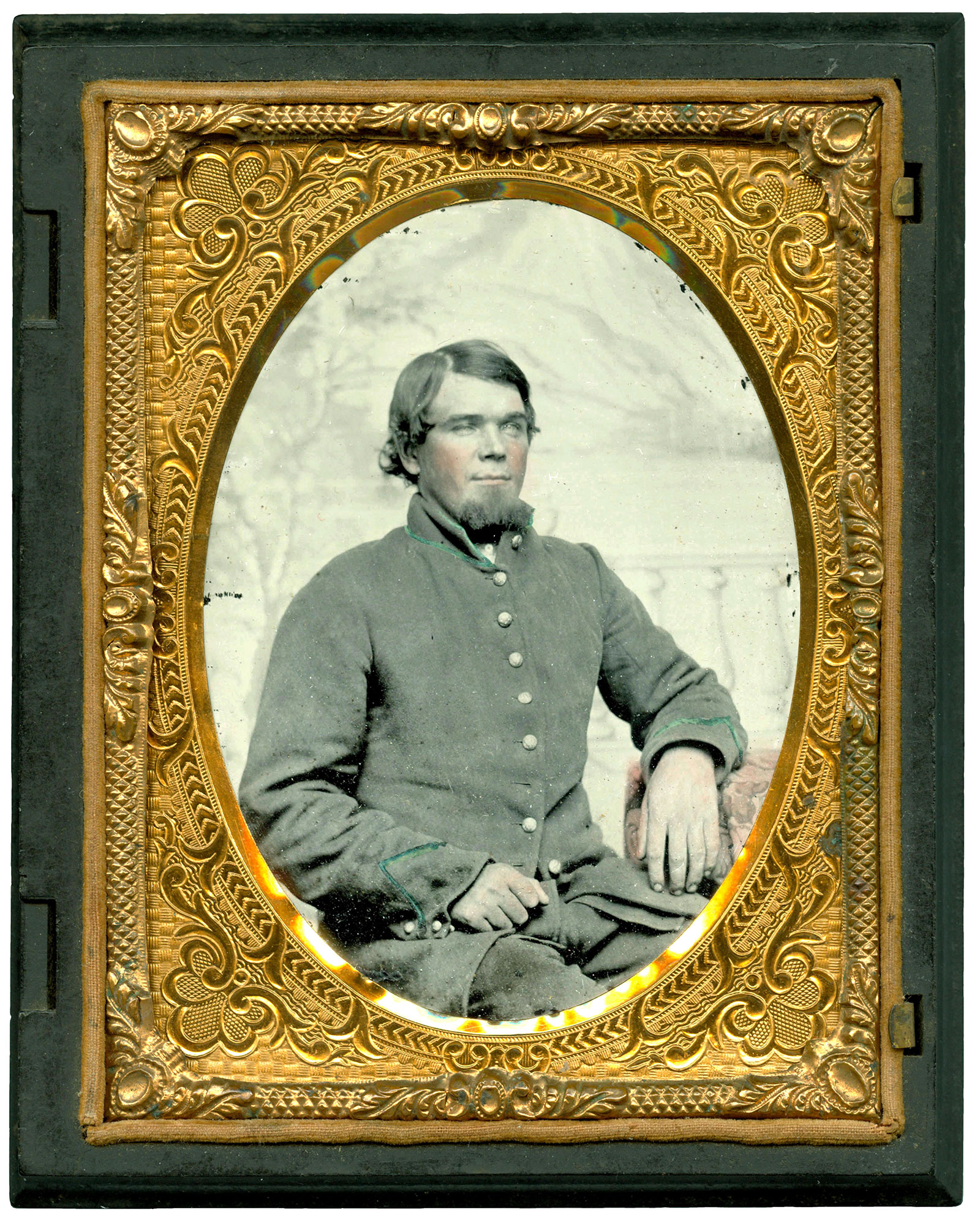
A German Volunteer
The German Rifles of Charleston included among its number Pvt. Henry Schmidt, the soldier tentatively identified in this portrait. Formed in 1837, the company became part of the 1st Regiment of Rifles, South Carolina Militia, when it was organized in 1859. Schmidt’s uniform, with green tinted cuffs and collar, and what appear to be Mexican War era regiment of Voltigeurs and foot riflemen V buttons suggest he was photographed before August 1861. At this time, the company was converted to infantry and attached to Hampton’s Legion.
The company was converted to artillery, and experienced a further reorganization along with the entire Legion in July 1862. As a result, it became an independent battery known as the German Light Artillery. Schmidt’s military record ends here.
Schmidt may have been in a hurry to fasten his coat for the photographer as the buttons and holes are not aligned!
This image appeared in Domenick A. Serrano’s Still More Confederate Faces (1992).
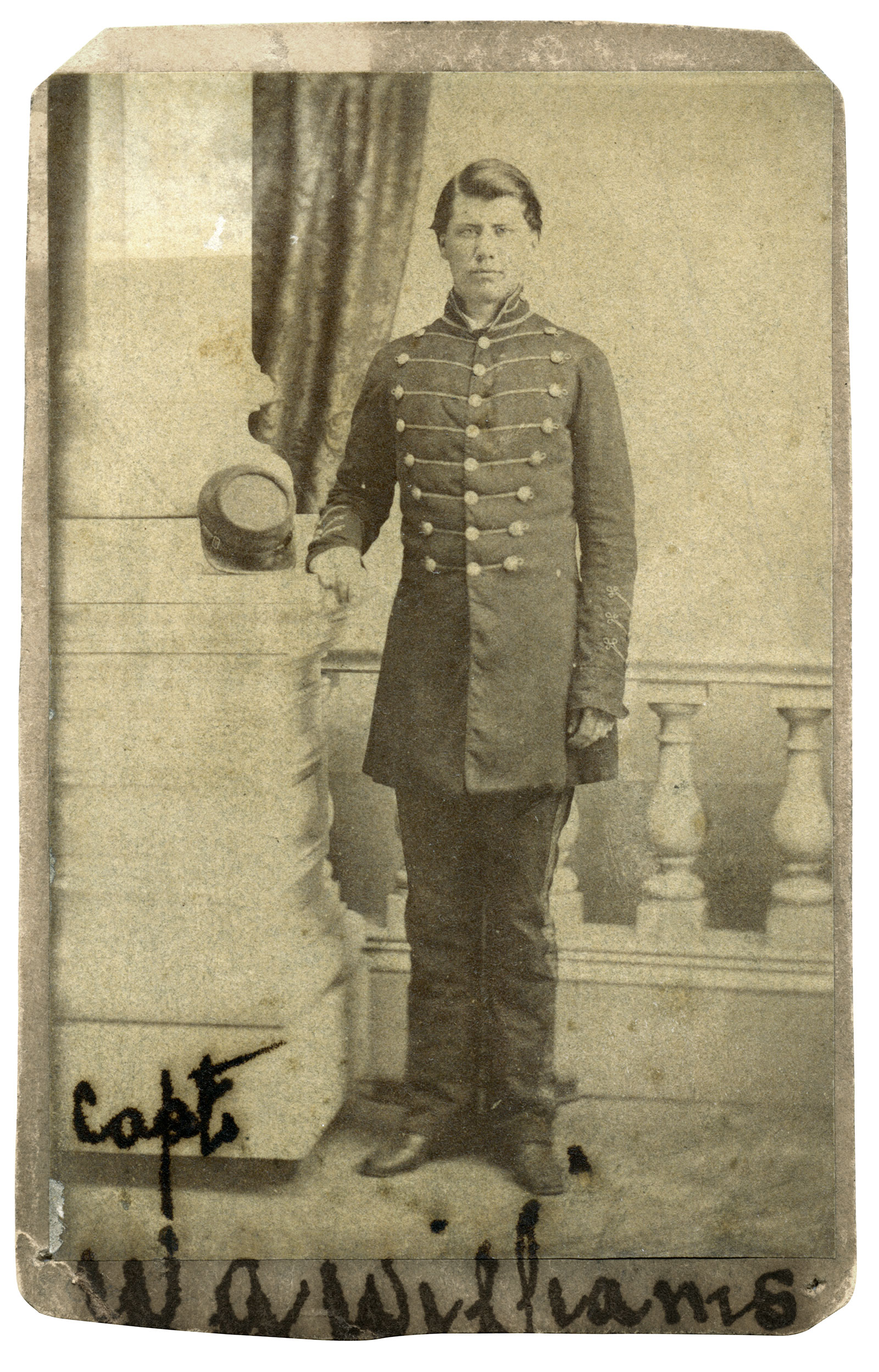
Chickamauga Casualty
In January 1861, the militiamen of the State Guards of Laurens Court House, S.C., entered into service 77 strong. Their number included law student William Albert Williams, the son of a wealthy planter known affectionately as “Puts.” Williams and his comrades mustered for state service as Company A of the 3rd South Carolina Infantry in June 1861. He started as first sergeant, and rose through the ranks in 1862. During this period, the 3rd distinguished itself in numerous engagements, including Antietam and Fredericksburg. Williams escaped these battles without injury, and also survived Chancellorsville and Gettysburg.
His luck ran out however, at Chickamauga, Ga., on Sept. 20, 1863. Serving as acting major, Williams was one of 26 men killed in his regiment.
Williams appears here early in the war, attired in the dark blue dress uniform of the State Guards. His chasseur-pattern cap rests on the column beside him.
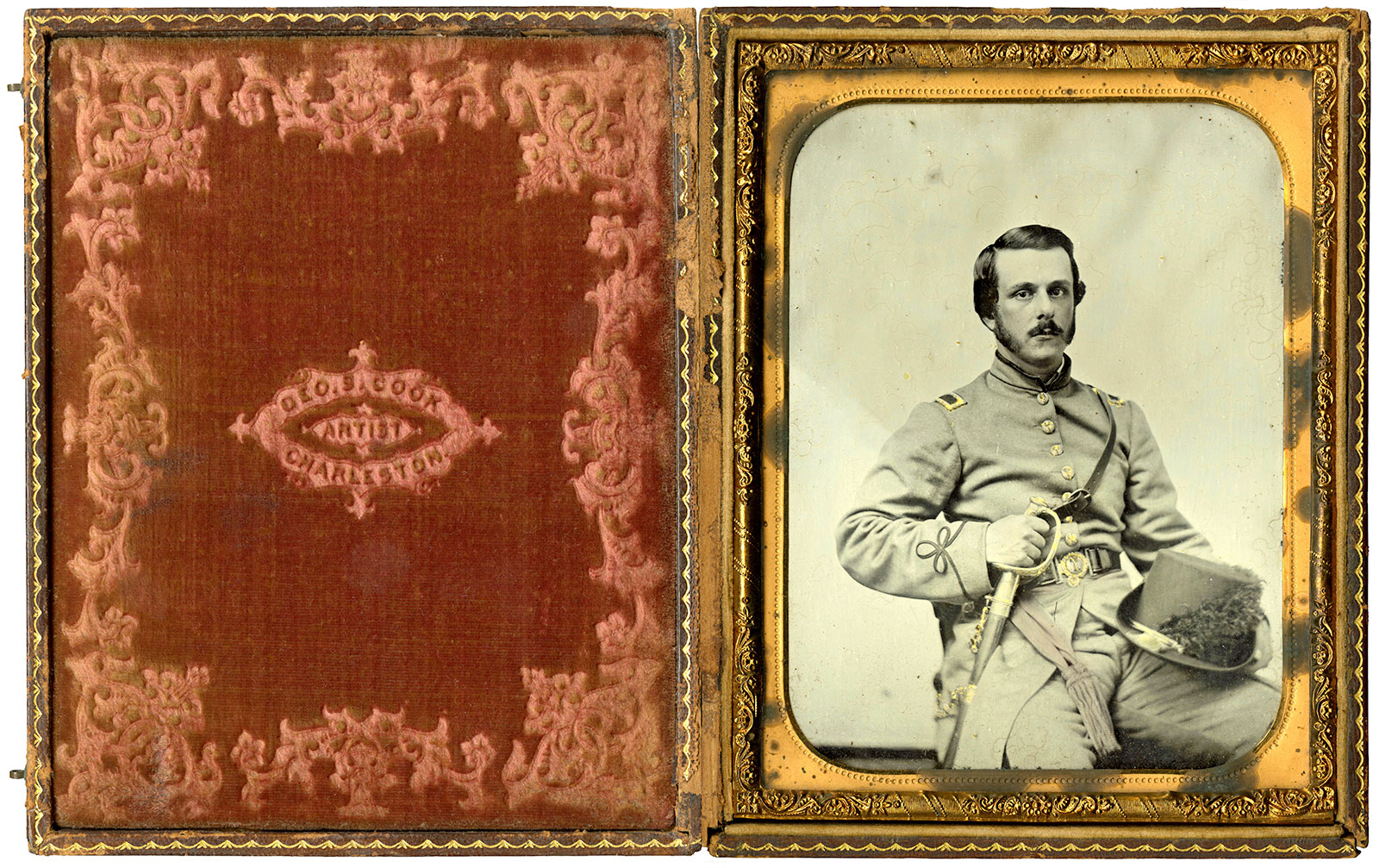
Half-plate ambrotype by George S. Cook of Charleston, S.C. Courtesy of Citadel Archives, Charleston, S.C.
Death Far From Home
Theodore Kekeley Klinck served as a second lieutenant in the Washington Light Infantry Volunteers, Company A of the infantry battalion of Hampton’s Legion, during the First Battle of Manassas on July 21, 1861. He “acted his part well” and survived without injury.
He was not as fortunate at the Battle of Seven Pines on May 31, 1862. Klinck, now first lieutenant in command of his company, was seriously wounded in the thigh and dragged out of range of fire, before being abandoned. He lay on the field for 18 hours without food or assistance before Union soldiers discovered him. Klinck was transported by ship to Philadelphia, and then on to a military hospital. According to one report, Klinck experienced the hostility of Philadelphians firsthand. “Stretched upon litters, was one who attracted much attention, from the fact that an attendant kept the face of the prostrate man carefully covered by a newspaper. There were many who surmise as to the motive for the concealment, and but few guessed its real object … He had his face covered … to escape the dreaded insults of the people of Philadelphia.”
A surgeon amputated Klinck’s leg, but “physical exhaustion caused him to sink under the effects of the operation.” He died on June 11, 1862.

